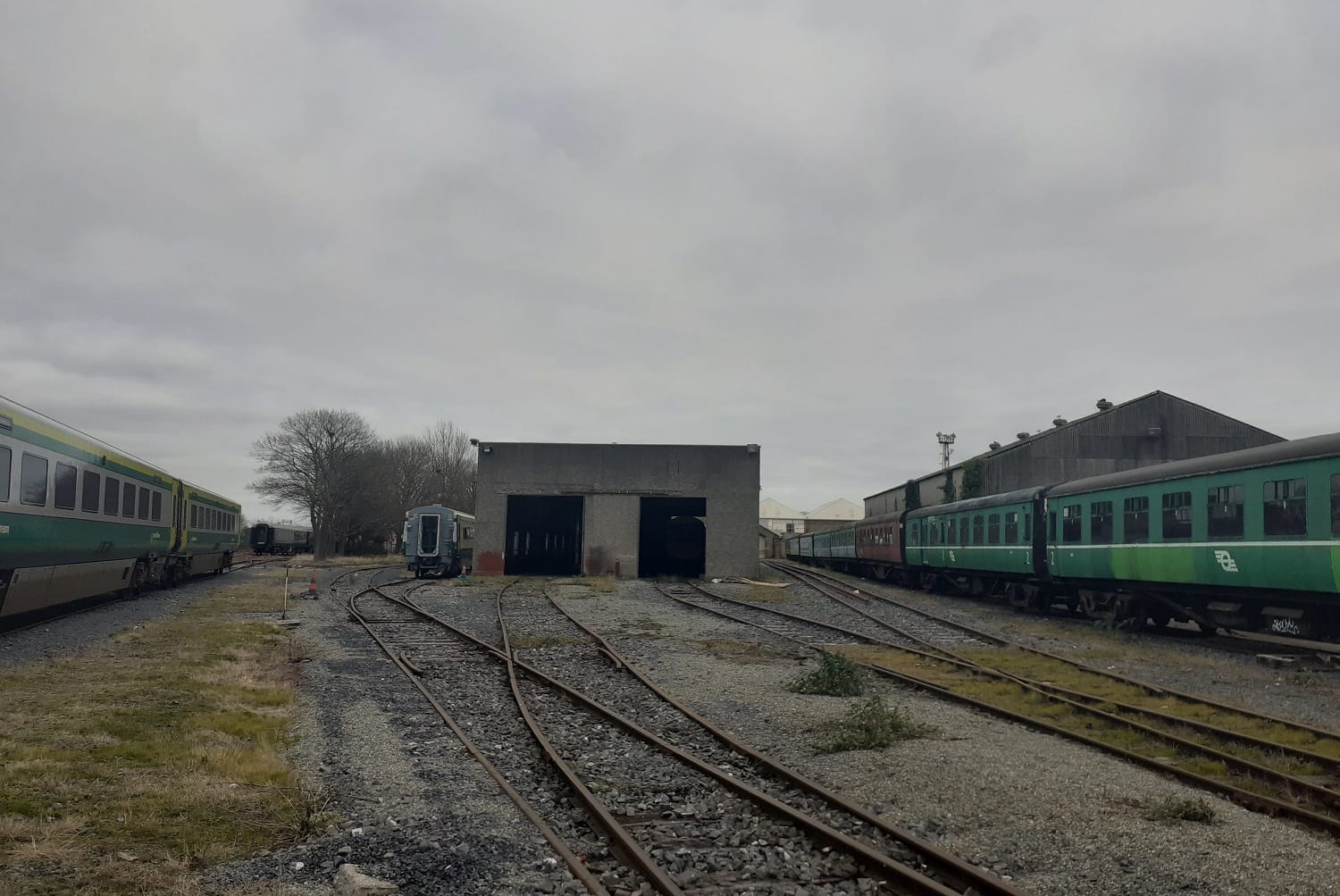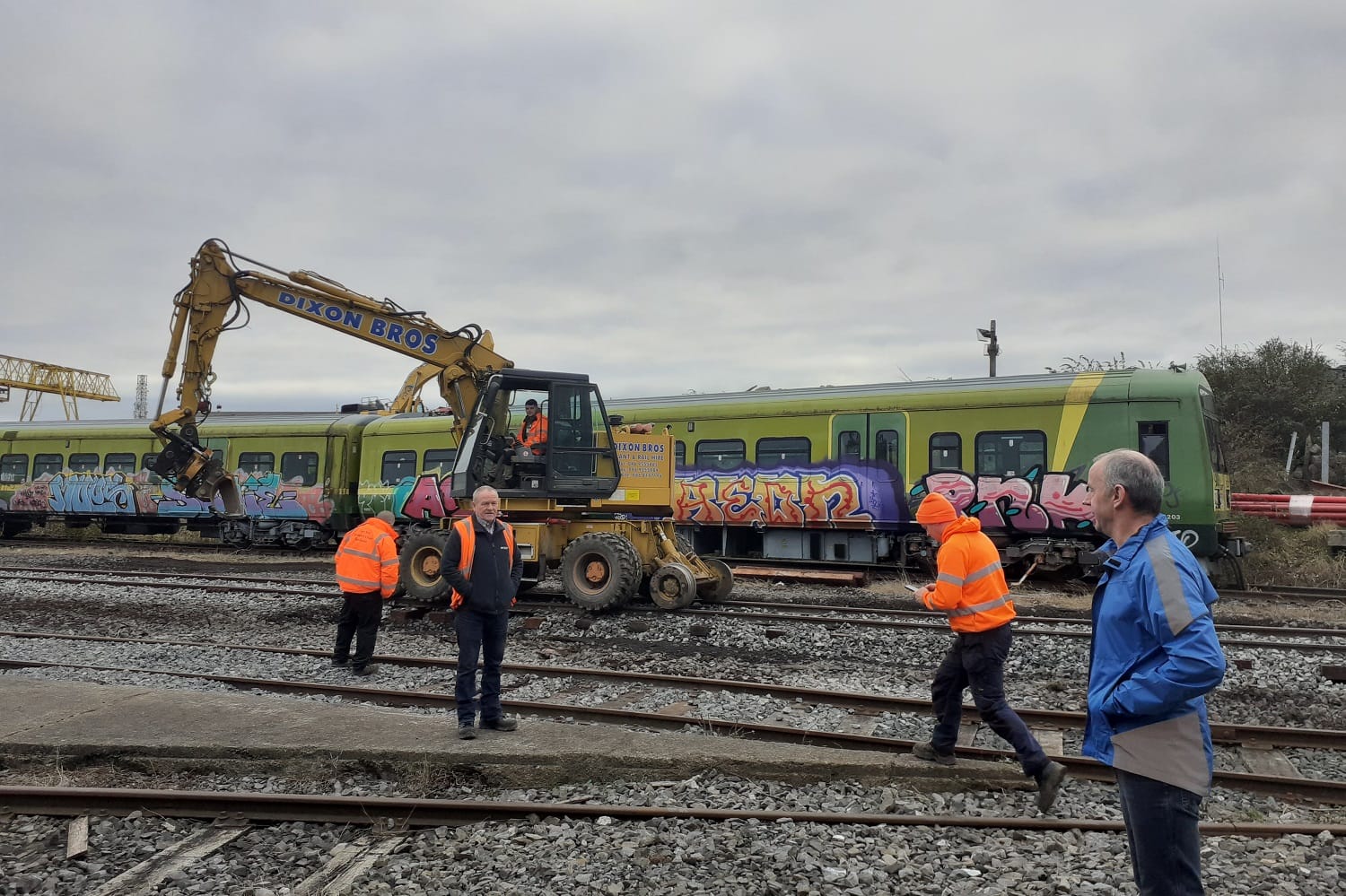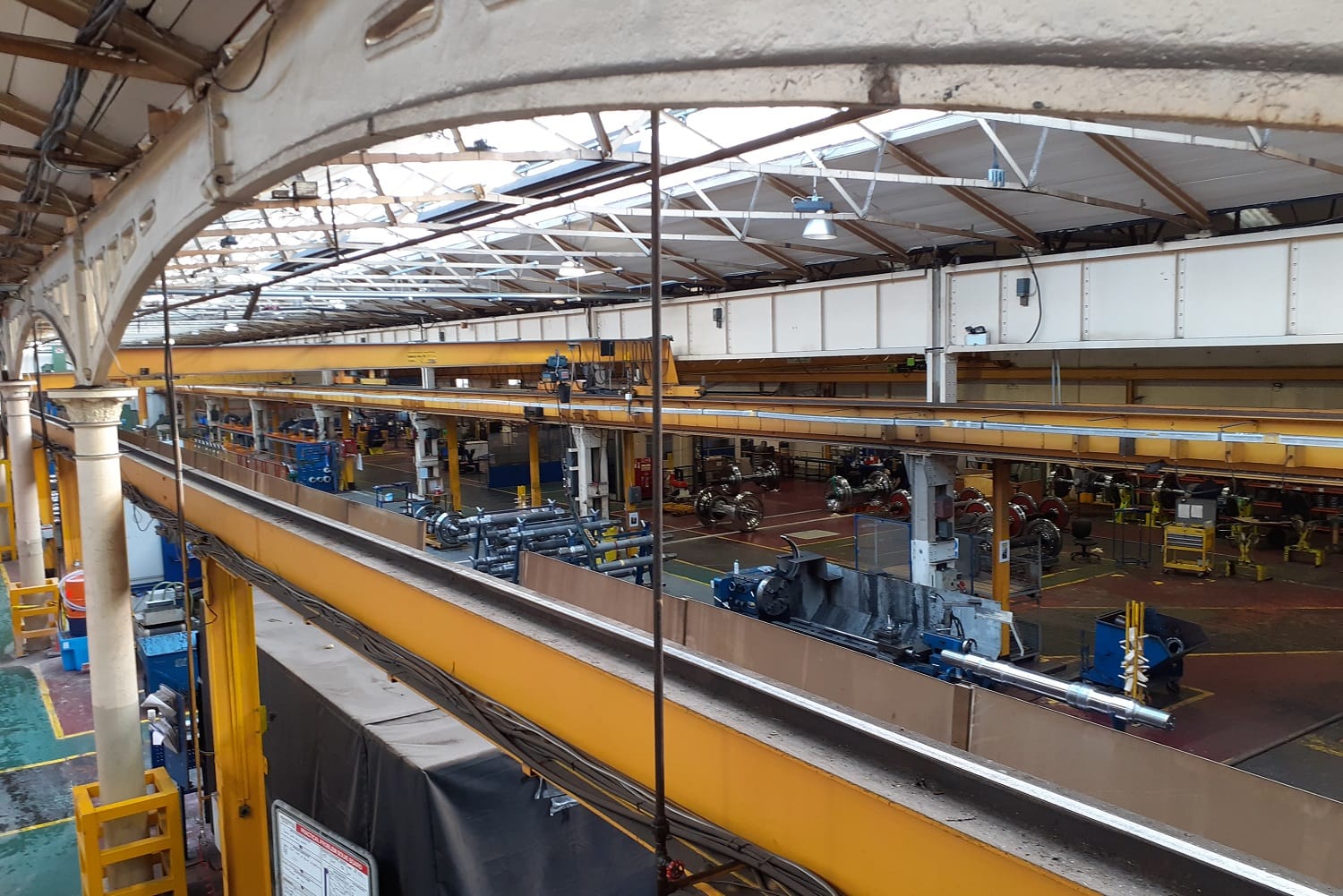What’s the best way to tell area residents about plans for a new asylum shelter nearby?
The government should tell communities directly about plans for new asylum shelters, some activists and politicians say.
Today, some workers there are treading the same floors as their fathers, grandfathers, and even great-grandfathers.

Paul Heneghan looks towards the large left-over carriages and trains, as he skips over the railway tracks in the eastern end of the Inchicore Railway Works.
“These are all abandoned,” he says. “They’re taken out of commission.”
He waves to a few workers in orange vests as they exit workshop buildings to his left, as he strolls comfortably across the stoney gravel.
It’s quieter than usual today, he says. And far quieter generally than when Henegan started working here in 1981, coming in as an apprentice fitter, and later teaching at the school.
He knows the place well. His father worked here as a driver. His maternal grandfather as a labourer.
Both Paul and his father lived in Abercorn Terrace, a row of two-storey red-brick homes on the eastern edge of the works.
Heneghan didn’t think he’d stay in the job 40 years, he says. But something kept him there.
“I just liked the smell, the smell of the place,” he says. “Smell of industry.”

In 1846, the year the Inchicore Railway Works opened, 39 men worked on the Inchicore site, says Mary Muldowney, a Dublin City Council historian-in-residence.
Many were key workers from Britain where more people had skills in rail, said Muldowney in a Richmond Barracks talk in 2019.
The number of workers grew quickly. In 1847, 251 men worked on the site, and began building houses for workers on the outskirts of the Inchicore land, she said.
At the end of the 19th century, 1,700 men and boys worked on the 73 acre site, and lived in the terraced houses around it, she said.
Only families with at least one member currently working in the Railway Works could live in these houses.
That’s one reason for the worker loyalty, says Muldowney. “That I think to a great extent is why that family commitment went down through generations.”
“It did encourage retention,” she says, “because people didn’t have to go elsewhere for somewhere to live.”
Upon retirement, without a family member working on site, she says, “you handed over the keys of your home and it was allocated to somebody else.”
In 1970, employees got the chance to buy their own homes. Heneghan says his father bought his home on Abercorn Terrace.
Almost 700 people work in the Inchicore Railway Works these days, said an Irish Rail spokesperson in October.
Mark Kirwan, a workshop executive at Irish Rail, says much of the physical maintenance is outsourced.
But it’s still, for some of the workers on the site, a job that has been passed down.
Many work here because they found out what the work is like from close relatives, says Kirwan. “It’s kind of a job for life, in a sense. You come in and you’re very secure in your work.”
Neal O’Hara’s strong connection with the railway comes from his father and older relatives having worked there, he says.
“You know people who did work here,” says O’Hara, a technical executive. “Whereas for my nephews and nieces, I’m the only one that they know.”

“You kind of look at things and wonder how it was done back in the day,” says Luke Lynch, an executive operative.
He stands at the top of a staircase to the break room, which overlooks the workshop floor scattered with steel machinery and bogies.
Lynch often thinks of how his family members did the same work as him, in the past.
His grandfather and great-grandfather were fitters here. He doesn’t know the details of their day-to-day, he says, but he hears bits from an uncle who was chairperson of Córas Iompair Éireann (CIÉ).
Workers today have so many machine helpers, he says , down on the workshop floor. “You’d kind of wonder how they would have managed to do that back in the day without the technology we have today.”
He uses a large axle scanner, which shows him on a screen whether there are cracks inside the axel that threaten breakdown.
Says Kirwan, eyeing the scanner: “There wasn’t that level of testing done previously. With safety standards now.” ?
Lynch says they must have been under a lot of pressure, in years past. “I don’t know how they managed to do it, with their hands nearly. It’s crazy.”
There’s loud steel banging in a room nearby. Someone is hammering one part into another, says Lynch. He pulls the break-room door shut.
“It’s very loud,” he says. “It would have been really loud though, back in the day.”
Lynch joined Irish Rail three years ago as an executive operative when he was 18, and has been in the wheel workshop since helping out the wheel fitters. “I like helping out people, getting the job done really.”
Train wheels come into the workshop used and worn. They seem ready to be binned, says Lynch. “Then you see it going out that was broken nearly last week, it’s brand new now.”
He likes working in the workshop and working with his hands, he says. “I’d be the first person since my grandfather that would be on the floor, working with the lads, rebuilding the train.”
“Continuing the legacy on,” he says, “running with the torch.”

From his computer in the design offices, Neal O’Hara can see the train tracks that travel on to Cork, Galway, and Westport.
Tacked onto the wall around the windows are sepia photos of men in overalls, hanging off bogies and steel beams.
Biro arrows point to some of the men. “Francis O’Hara”, “Joe O’Hara”, say the labels.
Neal O’Hara found the photos after his father died. He started building a family tree.
“I had this shoebox full of pictures,” he says. “I didn’t even know who these people were. It worked out great.”
He clicks on his computer through a family tree of 50 people, opening scans of birth and marriage certificates that show his great-grandfather Patrick, grandfather Fredrick, and father Robert worked in Inchicore Railway Works.
His father worked as a fitter-turner, assembling train parts, he says. “All of his brothers were as well.”
O’Hara started as an apprentice electrician, he says, the first in the family to not do fitter-turning. “I broke the mould when I did that.”
On his desk are steel parts and 3D-scan counterparts. O’Hara works in the design section, where he scans in steel parts that employees from workshops like Lynch’s have told him need new designs.
He’s the last one in his family to work for Irish Rail, he says. “It gives you a good sense of pride. Just to know that so many generations have worked here.”
One fading photo on the wall shows his grandfather Francis, standing proudly in front of the railway line and the Victorian-era lookout tower, on the outer wall of the wheel workshops building.
Paul Heneghan pushes open the door to a huge workshop.
Inside, green and grey InterCity trains and carriages resting after trips around the country are suspended above the ground on steel stilts.
Heneghan peers around under the trains. He’s looking for Mark, his son.
A couple of metres away on the workshop floor is a hefty train engine. “Hybrid engines,” says Paul.
Mark appears. He has been working on the engine for a year.
Paul perches on the edge of the black and silver engine, which is covered in curling steel tubes and colourful wires.
The engine will be finished testing stages in 2022, says Mark.
The gear boxes designed to to cut fuel consumption and make 18 percent fewer emissions, he says.
“So now we have to trial the new diesel engine. This has exhaust after-treatment installed. So that gives you your harmful-emissions reduction,” he says.
After the engine trial, they’ll start trialing the batteries.
Other members of Mark’s team are looking into hydrogen and electric trains, he says, so he feels optimistic for the future. “They’re pushing for as sustainable a company as they can get in the next couple of years.”
“It’s good. You just know you’re future-proofing the company,” he says.
Trains were built from scratch here at the peak of the site, says Kirwan, walking in an Irish Rail embroidered jacket and protective glasses, towards the tall sheds of the wheels workshops.
Says Heneghan: “We had everything.” All the equipment that they needed.
Now, some of the old stores and workshops are offices, he says, and the site is simply quieter. There’s less industry.
It’s a pity, he says. “But then again, it’s 40 years.” Things move on, he says, “That’s the way things evolve, they don’t stay still.”
With reports of long-term plans to build homes on part of the Inchicore site, Paul says he wouldn’t like to see it go ahead.
“Just not here. This is an industrial site,” he says. “You can’t just keep building houses and not put any sort of a centre to it.”

Paul says Mark was obsessed with trains as a child.
Mark beams. “Loved loved loved trains,” he says. “Everything – just the size, the power, how many people they move.”
If you’re standing on a platform beside one, and a train from Cork comes by, he says. “It’s 100 miles an hour, and it’s just that power that you feel. It’s just …”
As a kid, Paul would sneak over the tall walls to see the trains. They’d get as far as they could before being chased away by the warden, he says.
Mark too, says Mark, who grew up on Abercorn Terrace. “I’d kick the football over and I’d say I have to get over the wall to get the football, but I’d be taking a tour of the works.”
He’d admire the trains, he says. “If I could get into the cabin and take one, I’d take one. I was only six. I’ve always loved it.”
“I’d give anything just for here. Just even having me dad’s name, and everyone knows me dad around the works.”
“And he still got a job here,” says Paul, jokingly.
“It’s like an extended family,” says Mark. “And you’re talking to other people around the place, and their father would work here as well, there’s always little family connections.”
Mark thinks sometimes of his grandfather working here.
It makes him appreciate safety standards, he says, and how much easier it is now. “Everything’s pushed health and safety-wise, worker’s hours, everything. It’s just all different.”
“It’s one of the last places in Ireland that has real industry, real work that gets done,” he says.
“You have to be of a certain breed to be a train buff,” says Paul. “It’s everything on a big scale. It’s hard to explain.”
Mark says that growing up, every story told in the house would somehow come back to the railway.
“When my dad would be coming down for lunch, and the overalls would be dropped on the floor, the smell comes in. There’s a certain smell,” he says.
Mark had a baby boy in February, he says, called Cole. “And already now he sits there watching Thomas the Tank Engine.”
Get our latest headlines in one of them, and recommendations for things to do in Dublin in the other.